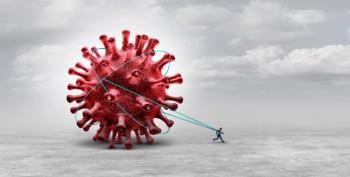
The BA.5 Variant Is Now Dominant: What News Outlets, Social Media Are Saying
White House COVID-19 coordinator Ashish Jha tweeted last week that “we know how to manage this moment.” News coverage and social media posting about the BA.5 variant crested as the variant became the dominant strain circulating in the U.S.
The CDC considers all the lineages of the omicron variant of the SARS-CoV-2 virus that causes COVID-19 to be “
The CDC lists seven omicron variants on its website: B.1.1.529, BA.1, BA.1.1, BA.2, BA.3, BA.4 and BA.5 lineages.
If there are all variants of concern, the BA.5 variant is, by far, the variants that is most concerning. It has become the main strain circulating in the U.S.
Coverage and social media chatter about BA.5 may be climbing as fast the transmission of the variant itself. Here is a round-up of some of that coverage:
The Daily Beast story, today:
The latest subvariant of the
The BA.5 subvariant of the basic
The Washington Post , July 10
America has decided the pandemic is over. The coronavirus has
The latest
The size of that wave is unclear because most people are testing at home or not testing at all. The Centers for Disease Control and Prevention in the past week has reported a little more than
But infectious-disease experts know that wildly underestimates the true number, which may be as many as a million, said Eric Topol, a professor at Scripps Research who closely tracks pandemic trends.
Antibodies from vaccines and previous covid infections offer limited protection against BA.5, leading
Financial Times , July 10
Hospital admissions are rising across Europe and the US as highly transmissible Covid-19 variants drive infections, but the resulting illness is less likely to be severe or cause death than in previous waves, according to data analyzed by the Financial Times and health experts. The number of new Covid admissions has grown by 40 per cent in the last week in France, 34 per cent in England and more than 20 per cent in several other European countries. The wave has been fueled by the BA.5 Omicron sub-variant. Maurizio Cecconi, president of the European Society of Intensive Care Medicine, said cases were rising in France, Italy and Germany. However, he added that cases had fallen in Portugal, which was in the vanguard of a fifth Covid wave in Europe.
Tom Frieden , M.D., M.P.H. former CDC director, July 8 tweet
Omicron sub-variants BA.4 and BA.5 are taking hold and may springboard us into a new infection surge. We can protect ourselves and others by staying up to date on vaccination, masking up when community transmission is high or if you’re at high risk, and staying home when sick.
Insider , July 8
Like the
"Those of us who've escaped for 2.5 years? It's gonna be hard to escape this one," Dr. Preeti Malani, an infectious disease physician from the University of Michigan, told Insider.
Dr. Amesh Adalja, senior scholar at Johns Hopkins Center for Health Security, said much the same.
"You cannot avoid a respiratory virus like this forever, unless you completely cease interaction with all other human beings," he said.
COVID-19 reinfections are spiking around the globe — in some cases, even people who were infected just
"If you were infected with the original Omicron, or even BA2.12.1, the
New York Times, July 7
The most transmissible variant yet of the coronavirus is threatening a fresh wave of infections in the United States, even among those who have recovered from the virus fairly recently.
The subvariant of Omicron known as
Though the popularity of home testing means reported cases are a significant undercount of the true infection rate, the share of tests that come back positive is shooting upward and is now higher than during most other waves of the pandemic. According to the C.D.C., the risk from Covid-19 is increasing in much of the country.
Yale Medicine , updated on July 6
In early July 2022, a strain called BA.5 — the most contagious one so far along with BA.4, another subvariant — is causing more than 50% of cases, making it the predominant strain in the United States. (BA.4 accounts for about 20% of all U.S. COVID cases.)
The original Omicron strain has a relatively mild version of the virus, causing less severe disease and death than Delta, which preceded it. While scientists are still learning about BA.5, data continues to show hospitalizations to be low compared to earlier in the pandemic. So far, the same can be said of infections, based on numbers from the Centers for Disease Control and Prevention (CDC). But that data does not include results from home tests.
Newsletter
Get the latest industry news, event updates, and more from Managed healthcare Executive.




















































